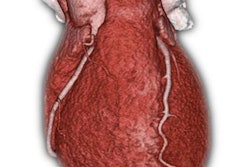Monday, November 28 | 3:10 p.m.-3:20 p.m. | SSE21-02 | Room S403A
Are lead aprons really helpful for reducing scatter radiation from CT? A study from the Mayo Clinic in Rochester, MN, casts doubt on the utility of shields placed outside the scan region.Lead aprons need to be placed away from the scan range to avoid being included in the scan, but this practice can reduce image quality and even increase dose when used with tube current modulation.
"If the lead is too close to the scan region, patient movement, or the need to scan a bit further, can cause the exam to be compromised," lead author Cynthia McCollough, PhD, told AuntMinnie.com. "Thus, we sought to determine the magnitude of dose reduction afforded by lead aprons."
The researchers placed head and abdominopelvic phantoms next to a chest phantom to mimic the body habitus of a 5-year-old. Chest CT (range, 20 cm) was then performed on a dual-source CT scanner with both tubes operating in high-pitch (flash) mode, and with a reference mAs 10 times the normal technique to allow measurements of the smallest scattered doses. A dosimeter measured the dose every 5 cm across the 25-cm scan range, and a 0.5-mm equivalent lead apron was placed at several distances from the scan range.
The researchers found that dose reduction diminishes rapidly when the lead apron is placed farther away from the scan field, and the dose reduction was negligible compared with the overall scan dose.
"The dose reduction using out-of-region shielding is extremely small," McCollough said. Due to multiple risks that will be revealed in the presentation, "lead shielding should not be used outside the scan field-of-view in CT," she said.




















